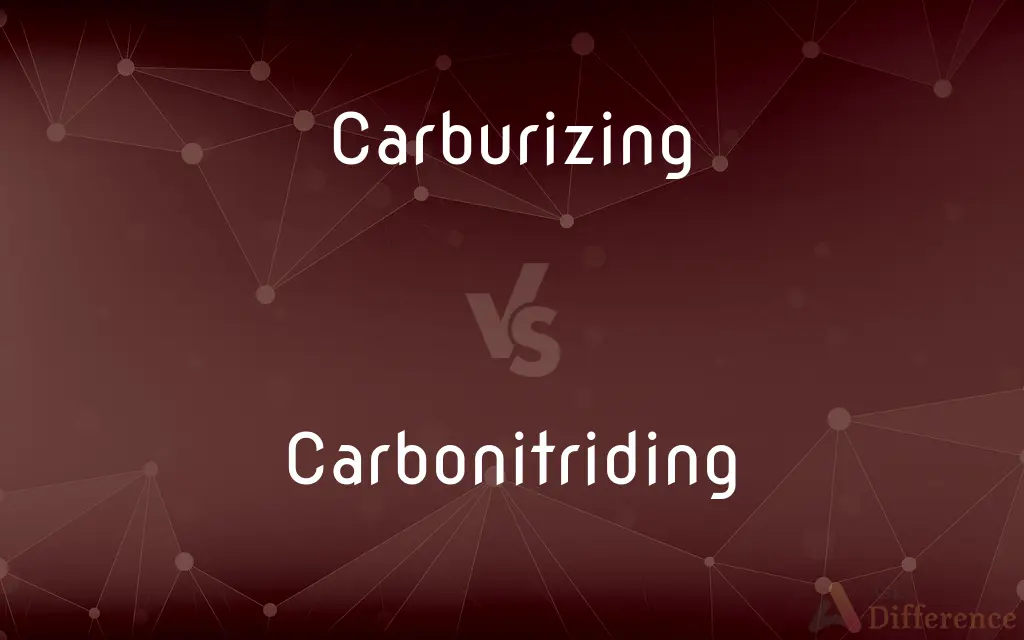Carburizing vs. Carbonitriding — What's the Difference?
By Urooj Arif & Maham Liaqat — Updated on April 16, 2024
Carburizing increases surface hardness by adding carbon to the outer layer of steel at high temperatures; carbonitriding also hardens surfaces by adding carbon and nitrogen, typically at lower temperatures and shorter times.

Difference Between Carburizing and Carbonitriding
Table of Contents
ADVERTISEMENT
Key Differences
Carburizing is a heat treatment process where steel is exposed to an environment rich in carbon at temperatures typically around 900°C to 950°C. Carbonitriding, on the other hand, involves adding both carbon and nitrogen to the steel, usually at slightly lower temperatures of 800°C to 850°C.
While carburizing is used to increase the carbon content on the surface of low carbon steels to improve hardness and wear resistance, carbonitriding also enhances fatigue and wear resistance but adds nitrogen to create a more uniform and harder case.
Carburizing often requires a longer time to achieve the desired depth and concentration of carbon. Carbonitriding, whereas, due to the addition of nitrogen, can achieve similar or superior properties in a shorter time.
The carburizing process is typically followed by quenching (rapid cooling) to lock the carbon in place and harden the steel. Carbonitriding also requires quenching but can result in less distortion and stress due to the lower treatment temperatures.
Carburizing is well-suited for low carbon steels needing a significant increase in surface hardness. Carbonitriding is preferred for parts that are thinner or more intricate, where lower temperatures reduce the risk of distortion or cracking.
ADVERTISEMENT
Comparison Chart
Main Elements Added
Carbon
Carbon and Nitrogen
Process Temperature
900°C to 950°C
800°C to 850°C
Treatment Time
Longer, to allow carbon diffusion
Shorter, due to accelerated diffusion with nitrogen
Material Suitability
Low carbon steels
Low carbon steels and alloys
Resulting Properties
High surface hardness, improved wear resistance
Uniform hardness, improved wear and fatigue resistance
Typical Applications
Gears, crankshafts, camshafts
Gears, dies, tools, and other intricate components
Compare with Definitions
Carburizing
A heat treatment process that increases the carbon content on the surface of steel.
Carburizing was used to harden the surface of the gear to withstand heavy loads.
Carbonitriding
Adds nitrogen to improve case hardening.
The addition of nitrogen during carbonitriding creates a tough outer layer on steel parts.
Carburizing
Usually followed by quenching to achieve desired hardness.
After carburizing, the steel part was quenched in oil to lock in the hardness.
Carbonitriding
A heat treatment that diffuses carbon and nitrogen into steel.
Carbonitriding was performed to enhance the surface hardness and fatigue resistance of the tool.
Carburizing
Enhances surface hardness while maintaining toughness inside.
Carburizing treatment ensured the camshaft resisted wear without becoming brittle.
Carbonitriding
Carried out at lower temperatures than carburizing.
Carbonitriding was chosen for the delicate metal components to prevent distortion.
Carburizing
Primarily used for parts requiring high surface strength.
Automotive transmission parts are often carburized for extra strength.
Carbonitriding
Suitable for intricate or thin parts due to mild process conditions.
The die used in high precision manufacturing was carbonitrided to improve its performance.
Carburizing
Involves heating steel in the presence of carbon.
The crankshaft underwent carburizing to improve its durability.
Carbonitriding
Results in less distortion and stress in treated parts.
To avoid warping the thin steel plates, carbonitriding was applied.
Carburizing
Carburising, carburizing (chiefly American English), or carburisation is a heat treatment process in which iron or steel absorbs carbon while the metal is heated in the presence of a carbon-bearing material, such as charcoal or carbon monoxide. The intent is to make the metal harder.
Carbonitriding
Carbonitriding is a metallurgical surface modification technique that is used to increase the surface hardness of a metal, thereby reducing wear. During the process, atoms of carbon and nitrogen diffuse interstitially into the metal, creating barriers to slip, increasing the hardness and modulus near the surface.
Carburizing
To treat, combine, or impregnate with carbon, as when casehardening steel.
Carbonitriding
Present participle of carbonitride
Carburizing
To carburet.
Carburizing
Present participle of carburize
Common Curiosities
Can both processes be applied to the same materials?
Both are generally used on low carbon steel but are chosen based on the specific application requirements.
What is the primary advantage of carburizing over carbonitriding?
Carburizing can create a deeper hardened surface, suitable for heavy-duty components.
Is carbonitriding considered a more modern technique?
Yes, carbonitriding is a more recent development that offers advantages in processing and material properties.
Why might one choose carbonitriding?
Carbonitriding is ideal for achieving a hard case with less risk of distortion, especially in thinner or more complex parts.
What are the environmental impacts of these processes?
Both processes require significant energy and can produce emissions, but advancements are aiming to reduce their environmental footprints.
How does quenching influence these heat treatments?
Quenching rapidly cools the steel, locking in the hardness induced by added carbon or nitrogen.
How do the added elements affect the steel?
Carbon increases hardness and wear resistance, while nitrogen enhances surface uniformity and fatigue resistance.
What is the typical industry for using carburizing?
Automotive and aerospace industries often use carburizing for parts like gears and shafts.
What are the cost implications of each process?
Carburizing can be more costly and time-consuming due to higher temperatures and longer cycle times.
Are there alternatives to these heat treatments?
Other processes like nitriding or boronizing also alter surface properties but through different mechanisms.
Share Your Discovery

Previous Comparison
Cysteine vs. Cystine
Next Comparison
Wool vs. CottonAuthor Spotlight
Written by
Urooj ArifUrooj is a skilled content writer at Ask Difference, known for her exceptional ability to simplify complex topics into engaging and informative content. With a passion for research and a flair for clear, concise writing, she consistently delivers articles that resonate with our diverse audience.
Co-written by
Maham Liaqat














































